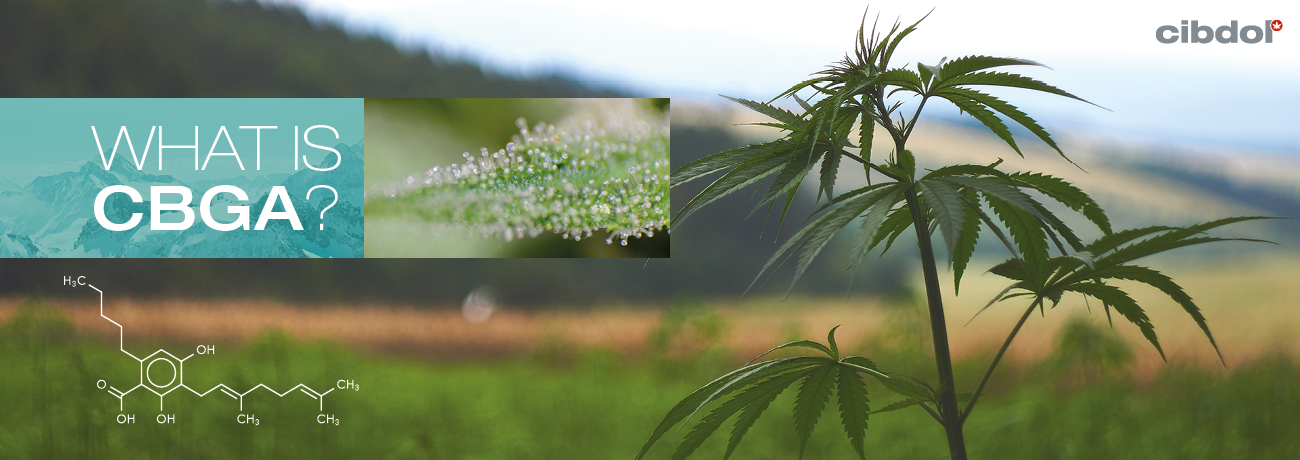Cannabigerolic Acid (CBGA): Everything You Need to Know

CBGA is known as the "mother cannabinoid", effectively acting as the precursor to all members of the cannabinoid family. But its role in cannabinoid biosynthesis isn’t the only feature worth exploring—CBGA may also have applications relevant to humans. Keep reading to find out more.
Contents:
What is CBGA?
CBGA, or cannabigerolic acid, plays a key role in the creation of all cannabinoids inside hemp and cannabis. It's widely regarded as the "mother cannabinoid", as cannabinoids such as CBD, CBC, and THC wouldn't exist without it. In fact, without CBGA, no other cannabinoids would exist!
However, CBGA's role in cannabinoid biosynthesis actually took considerable time to uncover. The realisation eventually came to light in the late nineties, some thirty-odd years after its initial discovery, courtesy of Japanese scientists.[1] Still, you're probably wondering, how exactly does a single compound pave the way for over a hundred unique cannabinoids?
Where does CBGA come from?
CBGA's origin story starts during the earliest stages of the cannabis plant's development. Through a series of chemical reactions, cannabis trichomes create olivetolic acid (OA) and geranyl diphosphate (GPP), and these molecules are then converted into CBGA.
Once synthesised, CBGA can become a multitude of cannabinoid acids, depending on which enzyme catalyses the reaction. THCA synthase, CBDA synthase, and CBCA synthase convert CBGA into THCA, CBDA, and CBCA, respectively.
However, CBGA can also be converted into the cannabinoid CBG if exposed to the right conditions. When exposed to heat, a carboxyl group detaches from the molecule. This process—known as decarboxylation—creates CBG.
CBGA also plays other fundamental roles in the cannabis plant. As a secondary metabolite, it helps to direct resources toward the flowers for resin and seed production. The molecule achieves this impressive feat by supporting programmed cell death in the leaves, which frees up critical energy.
What's the difference between CBGA and CBG?
CBGA and CBG differ chemically, as the former is an acid compound only present in raw plant material, while the latter is decarboxylated. However, significant distinctions between the cannabinoids seem to end there, for now. As the investigation of both CBG and CBGA is ongoing, we know very little at present.
Given that scientists didn't uncover the role of CBGA in cannabinoid biosynthesis until 1996, our understanding of the compound is limited. We know that both interact with the human body via the endocannabinoid system (ECS) and its various receptors. To which receptors these compounds may bind, and to what extent, remains to be seen.
Encouragingly, both compounds appear non-psychotropic, meaning they don't induce a high; but the lack of data also means we don’t know whether these cannabinoids interact with medications. In short, early indications of CBGA and CBG appear positive, but we simply don't understand enough about either cannabinoid to confirm their safety.[2]
How does CBGA work?
Although we know very little, we can examine available research to see how CBGA may work in the body:
• Some early indications suggest CBG has a unique relationship with adrenoceptors and 5-HT receptors, which indicates a potentially similar interaction with CBGA.[3]
• CBG is thought to be a weak or partial agonist of CB1 and CB2,[4] but very little of this relationship has been elucidated, and is therefore unproven.
• CBGA plays a crucial role in the entourage effect, a phenomenon wherein the combined potential of cannabinoids, terpenes, and other compounds inside cannabis is enhanced. For example, full-spectrum cannabinoid products take advantage of this phenomenon to improve the overall influence on well-being.

What are the effects of CBGA?
Research into CBGA is incredibly limited, with only a handful of studies available for review:
• CBGA and diabetes: A study in the journal Fitoterapia looked at the effect of a high-CBGA strain on the enzyme aldose reductase—a molecule associated with diabetes.[5]
• CBGA and metabolism: A 2019 paper in Biochimica et Biophysica Acta details computational and cell research that suggests the cannabinoid acid can bind to peroxisome proliferator-activated receptors (PPARs), which are associated with metabolism.[6]
• CBGA and cancer cells: Researchers in Israel tested "unheated cannabis extracts (C2F), fraction 7 (F7), and fraction 3 (F3)" on colon cancer cells.[7]
• CBGA and COVID-19: Two Oregon universities collaborated to test the efficacy of cannabinoids against SARS-CoV-2.[8]
Although it may seem that there's limited interest in CBGA, the lack of research is not without good reason. Given that cannabigerolic acid is the precursor to all cannabinoids, it is incredibly difficult to isolate.
However, with the recent interest in CBGA thanks to COVID-19 research, there's no doubt we'll see a renewed focus on its practical applications.
Browse the Cibdol store to discover a range of full-spectrum products capitalising on the entourage effect. Or, to learn more about acidic cannabinoids and the chemical reactions inside hemp, visit our CBD Encyclopedia for everything you need to know.
FAQ
- Is CBGA legal?
- As a non-psychotropic cannabinoid acid, CBGA is legal in many of the same countries as CBD. CBG is obtained from low-THC hemp crops currently legal in the United States and many European countries.
- Is CBGA the same as CBG?
- CBGA is an acid precursor to CBG, meaning its impact on the human body may differ. Research is currently determining the key differences between these compounds.
[1] Taura F, Morimoto S, Shoyama Y. Purification and characterization of cannabidiolic-acid synthase from Cannabis sativa L.. Biochemical analysis of a novel enzyme that catalyzes the oxidocyclization of cannabigerolic acid to cannabidiolic acid. The Journal of Biological Chemistry. 1996;271(29):17411-17416. doi:10.1074/jbc.271.29.17411 [Source]
[2] Nachnani R, Raup-Konsavage WM, Vrana KE. The Pharmacological Case for Cannabigerol. The Journal of Pharmacology and Experimental Therapeutics. 2021;376(2):204-212. doi:10.1124/jpet.120.000340 [Source]
[3] Nachnani R, Raup-Konsavage WM, Vrana KE. The Pharmacological Case for Cannabigerol. The Journal of Pharmacology and Experimental Therapeutics. 2021;376(2):204-212. doi:10.1124/jpet.120.000340 [Source]
[4] Nachnani R, Raup-Konsavage WM, Vrana KE. The Pharmacological Case for Cannabigerol. The Journal of Pharmacology and Experimental Therapeutics. 2021;376(2):204-212. doi:10.1124/jpet.120.000340 [Source]
[5] Smeriglio A, Giofrè SV, Galati EM, et al. Inhibition of aldose reductase activity by Cannabis sativa chemotypes extracts with high content of cannabidiol or cannabigerol. Fitoterapia. 2018;127:101-108. doi:10.1016/j.fitote.2018.02.002 [Source]
[6] D’Aniello E, Fellous T, Iannotti FA, et al. Identification and characterization of phytocannabinoids as novel dual PPARα/γ agonists by a computational and in vitro experimental approach. Biochimica Et Biophysica Acta General Subjects. 2019;1863(3):586-597. doi:10.1016/j.bbagen.2019.01.002 [Source]
[7] Nallathambi R, Mazuz M, Namdar D, et al. Identification of Synergistic Interaction Between Cannabis-Derived Compounds for Cytotoxic Activity in Colorectal Cancer Cell Lines and Colon Polyps That Induces Apoptosis-Related Cell Death and Distinct Gene Expression. Cannabis and Cannabinoid Research. 2018;3(1):120-135. doi:10.1089/can.2018.0010 [Source]
[8] van Breemen RB, Muchiri RN, Bates TA, et al. Cannabinoids Block Cellular Entry of SARS-CoV-2 and the Emerging Variants. Journal of Natural Products. Published online January 10, 2022. doi:10.1021/acs.jnatprod.1c00946 [Source]
[1] Taura F, Morimoto S, Shoyama Y. Purification and characterization of cannabidiolic-acid synthase from Cannabis sativa L.. Biochemical analysis of a novel enzyme that catalyzes the oxidocyclization of cannabigerolic acid to cannabidiolic acid. The Journal of Biological Chemistry. 1996;271(29):17411-17416. doi:10.1074/jbc.271.29.17411 [Source]
[2] Nachnani R, Raup-Konsavage WM, Vrana KE. The Pharmacological Case for Cannabigerol. The Journal of Pharmacology and Experimental Therapeutics. 2021;376(2):204-212. doi:10.1124/jpet.120.000340 [Source]
[3] Nachnani R, Raup-Konsavage WM, Vrana KE. The Pharmacological Case for Cannabigerol. The Journal of Pharmacology and Experimental Therapeutics. 2021;376(2):204-212. doi:10.1124/jpet.120.000340 [Source]
[4] Nachnani R, Raup-Konsavage WM, Vrana KE. The Pharmacological Case for Cannabigerol. The Journal of Pharmacology and Experimental Therapeutics. 2021;376(2):204-212. doi:10.1124/jpet.120.000340 [Source]
[5] Smeriglio A, Giofrè SV, Galati EM, et al. Inhibition of aldose reductase activity by Cannabis sativa chemotypes extracts with high content of cannabidiol or cannabigerol. Fitoterapia. 2018;127:101-108. doi:10.1016/j.fitote.2018.02.002 [Source]
[6] D’Aniello E, Fellous T, Iannotti FA, et al. Identification and characterization of phytocannabinoids as novel dual PPARα/γ agonists by a computational and in vitro experimental approach. Biochimica Et Biophysica Acta General Subjects. 2019;1863(3):586-597. doi:10.1016/j.bbagen.2019.01.002 [Source]
[7] Nallathambi R, Mazuz M, Namdar D, et al. Identification of Synergistic Interaction Between Cannabis-Derived Compounds for Cytotoxic Activity in Colorectal Cancer Cell Lines and Colon Polyps That Induces Apoptosis-Related Cell Death and Distinct Gene Expression. Cannabis and Cannabinoid Research. 2018;3(1):120-135. doi:10.1089/can.2018.0010 [Source]
[8] van Breemen RB, Muchiri RN, Bates TA, et al. Cannabinoids Block Cellular Entry of SARS-CoV-2 and the Emerging Variants. Journal of Natural Products. Published online January 10, 2022. doi:10.1021/acs.jnatprod.1c00946 [Source]







